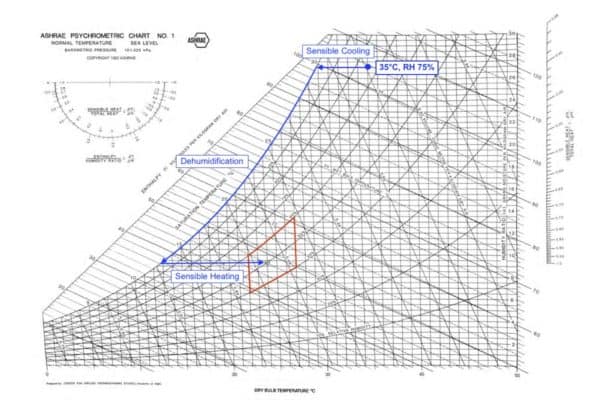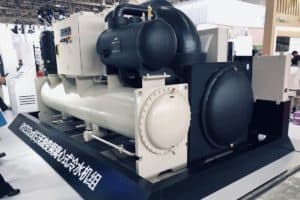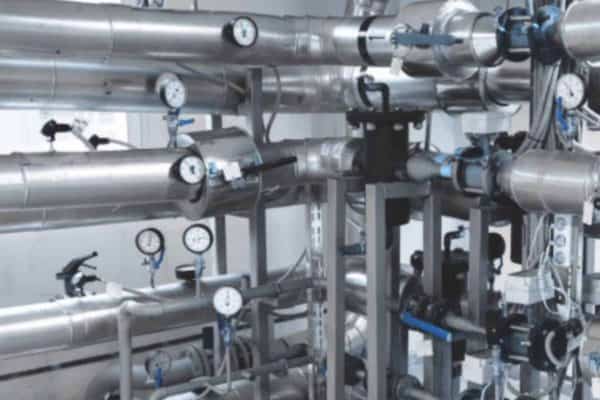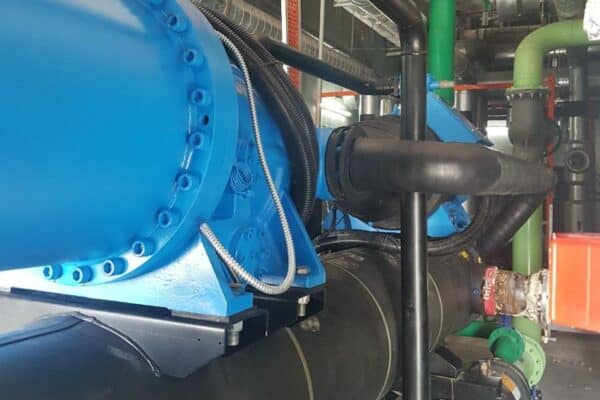PH Diagram for Refrigeration Cycle In-Depth Explanation
PH diagram for the refrigeration cycle is one of the essential elements in air conditioning. It is fundamental to how air conditioners work. However, it is not well understood by many HVAC engineers. So, I’ll explain the PH diagram for refrigeration in detail.
In this post, I’ll go through the basics of a PH diagram and how to read it. From there, we’ll discuss each of the points in the PH diagram and see how they relate to the actual operation of air conditioners. Then, I’ll show you some of the things you can derive from the PH diagram.
Since R410A is currently the most common refrigerant, I’ll use it for this post. Without further ado, let’s get started.
What is PH Diagram in Refrigeration?
In refrigeration, the pressure-enthalpy diagram or P-H diagram shows how the pressure of a refrigerant (working fluid) changes when heat (enthalpy) is given to the refrigerant or taken from the refrigerant.
Since pressure is directly proportional to temperature, the PH diagram also provides us with the temperature of the refrigerant at any given conditions.
In addition, the PH diagram lets us know the state of the refrigerant at a given pressure, temperature and enthalpy, namely liquid, gas (or vapour) and liquid-gas mixture.
The reason why refrigerants are used in air conditioning to move heat around is that they will change their state at practical temperatures and pressures.
As we all know, during a state or phase change (eg: gas to liquid), a huge amount of heat can be absorbed or released. The amount of heat that can be transferred during a phase change (latent heat) is much greater than the amount of heat that can be transferred without a phase change (specific heat).
In a refrigeration system, we want the refrigerant to change phase so that the heat transfer is efficient. Hence, the PH diagram gives us the information we need to control the refrigerant state.
In the meantime, I would like to inform you that you can learn quicker by getting my HVAC Begin (eBook) if you’re a beginner. But, if you have a year or two of experience, then I would suggest you consider my HVAC Basics (eBook). Nonetheless, I encourage you enroll in my HVAC Beginner Course: 10 Days to Become Competent in HVAC if you want to equipped yourself with a complete set of basic HVAC skills.
HVAC Beginner Course
Learn the most basics and foundational HVAC skills including cooling capacity calculation, equipment selection, duct sizing, pipe sizing, exhaust fan sizing, controls, electrical and more.
How to Read PH Diagram for Refrigerant?
PH diagrams come in two different units of measurement; a) Imperial and b) SI. Since the capacity of air conditioners is mostly rated in btu/hr. I’ll be using the PH diagram in the Imperial unit.
Besides, there are many different refrigerants and each refrigerant has its own PH diagram because they all behave differently.
Below is the R410A PH diagram:
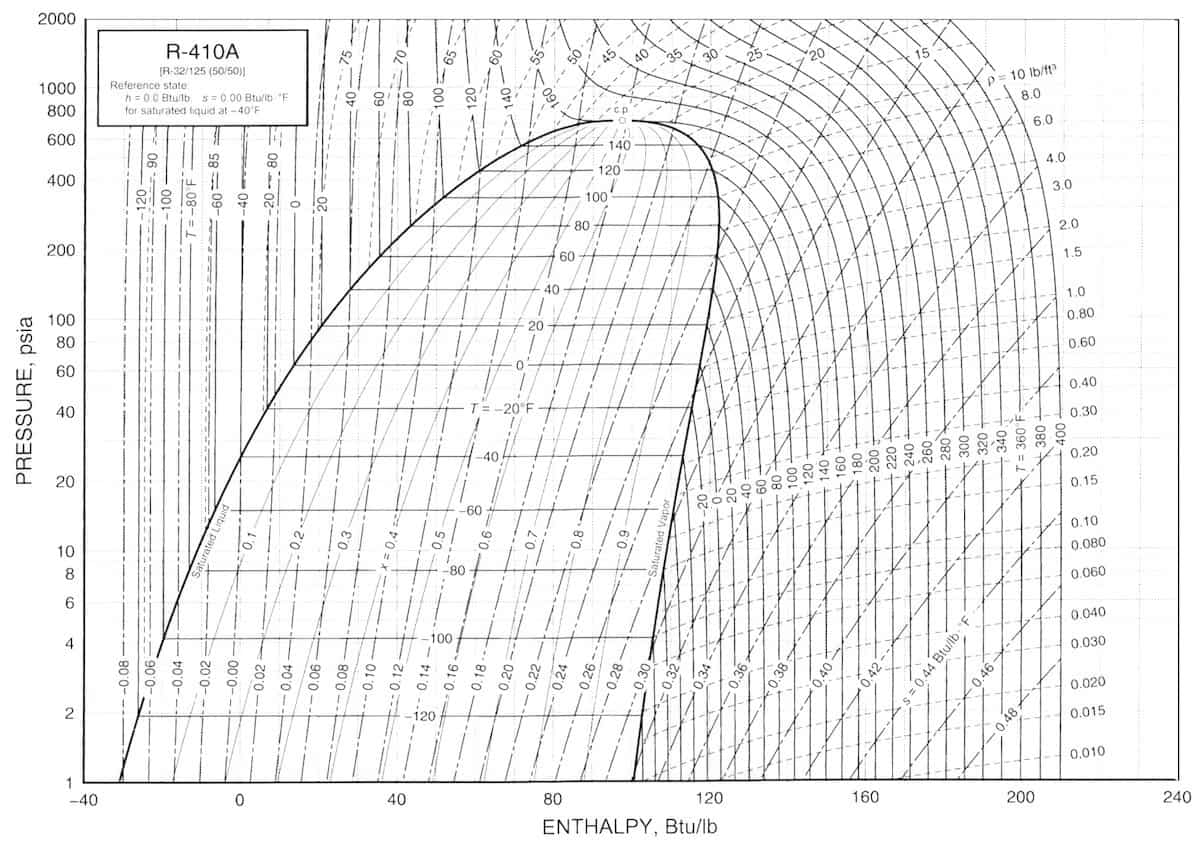
Now, let’s understand how to read the PH diagram first by looking at the different axis on the PH diagram.
Refrigerant Pressure
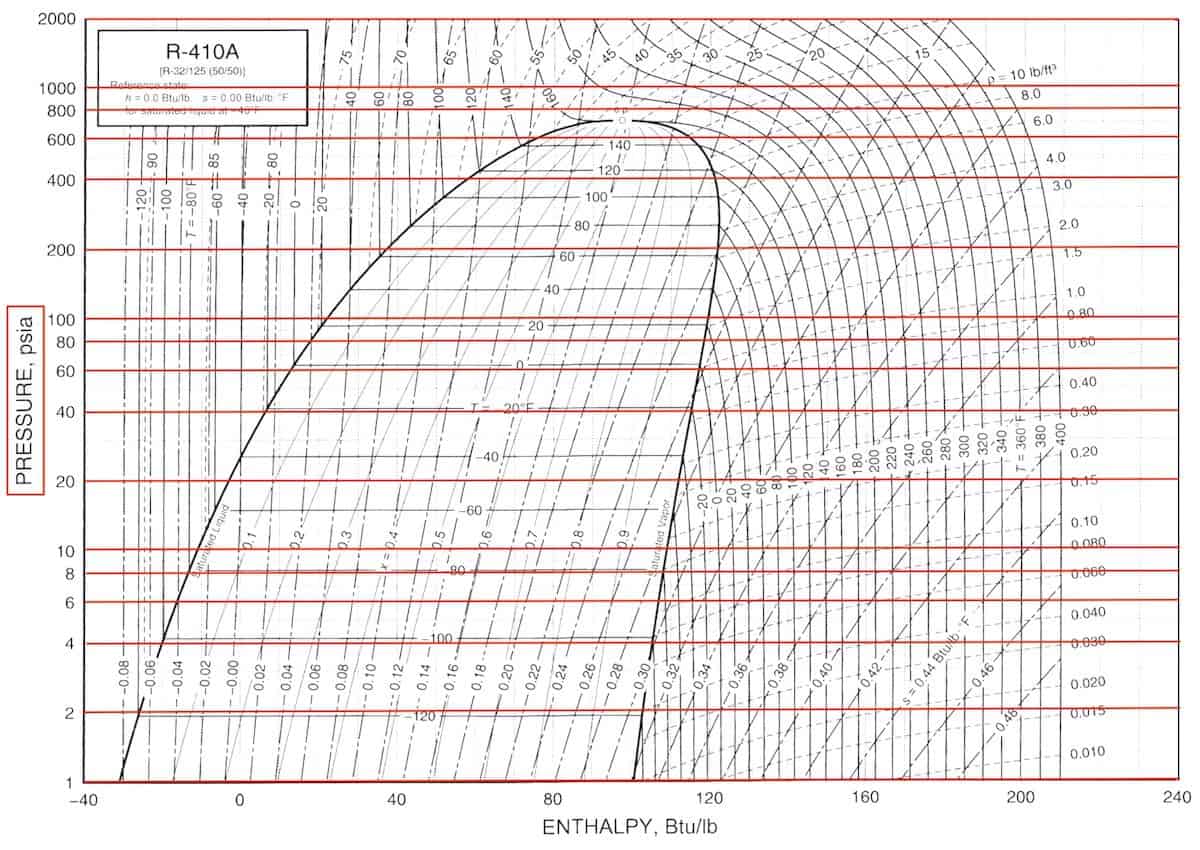
Most people know about refrigerant pressure. It is the most common thing we talk about when it comes to the refrigeration cycle. For instance, we often ask what is the pressure of the refrigerant in an air conditioner.
So, the horizontal axis on the PH diagram represents the pressure of the refrigerant. In the Imperial unit, the refrigerant pressure is shown in terms of psia.
Refrigerant Enthalpy
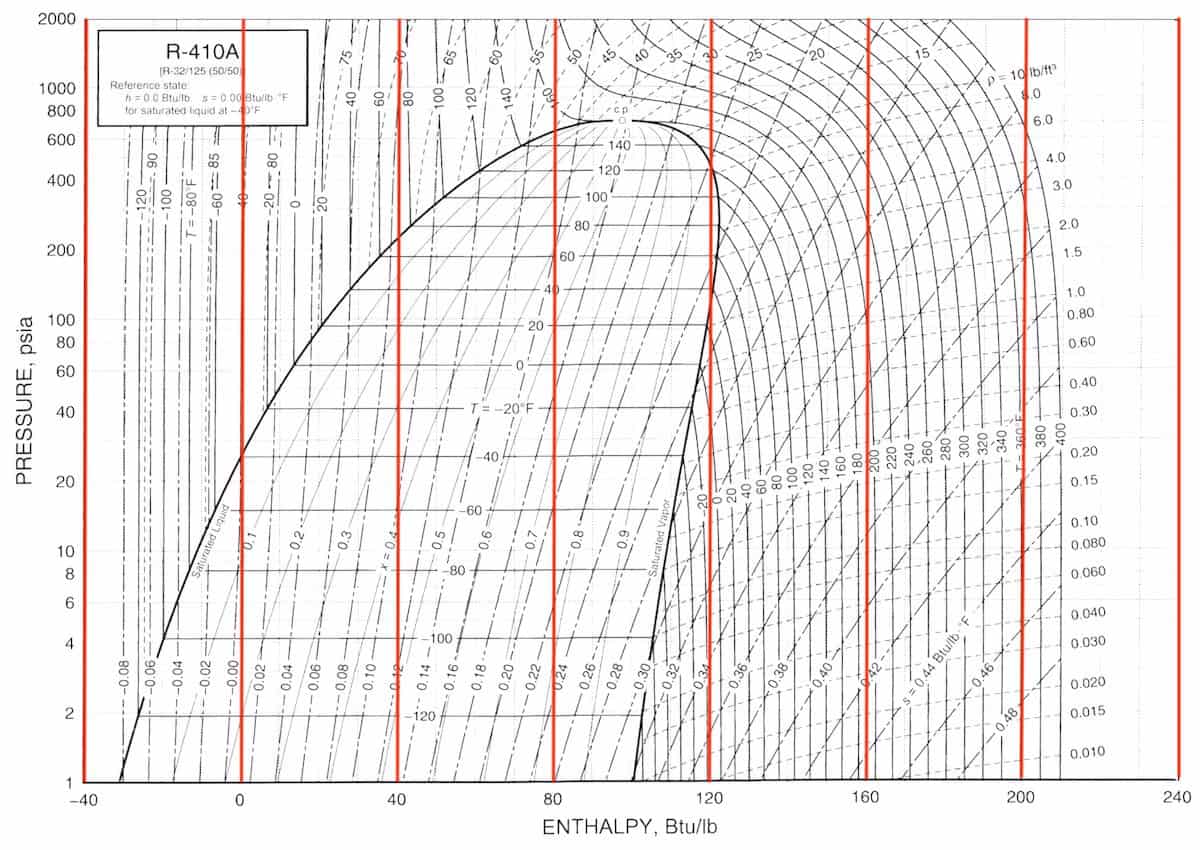
Enthalpy is a very confusing concept to many people. Basically, we can think of enthalpy as energy or heat. The more heat you give to the refrigerant, the higher the enthalpy of the refrigerant.
In the Imperial unit, the refrigerant enthalpy is shown in terms of btu/lb or btu per pound of refrigerant. Therefore, the more refrigerant you have (higher lb), the greater the energy you can move around (more btu).
The vertical lines on the PH diagram represent the enthalpy of the refrigerant.
Refrigerant State
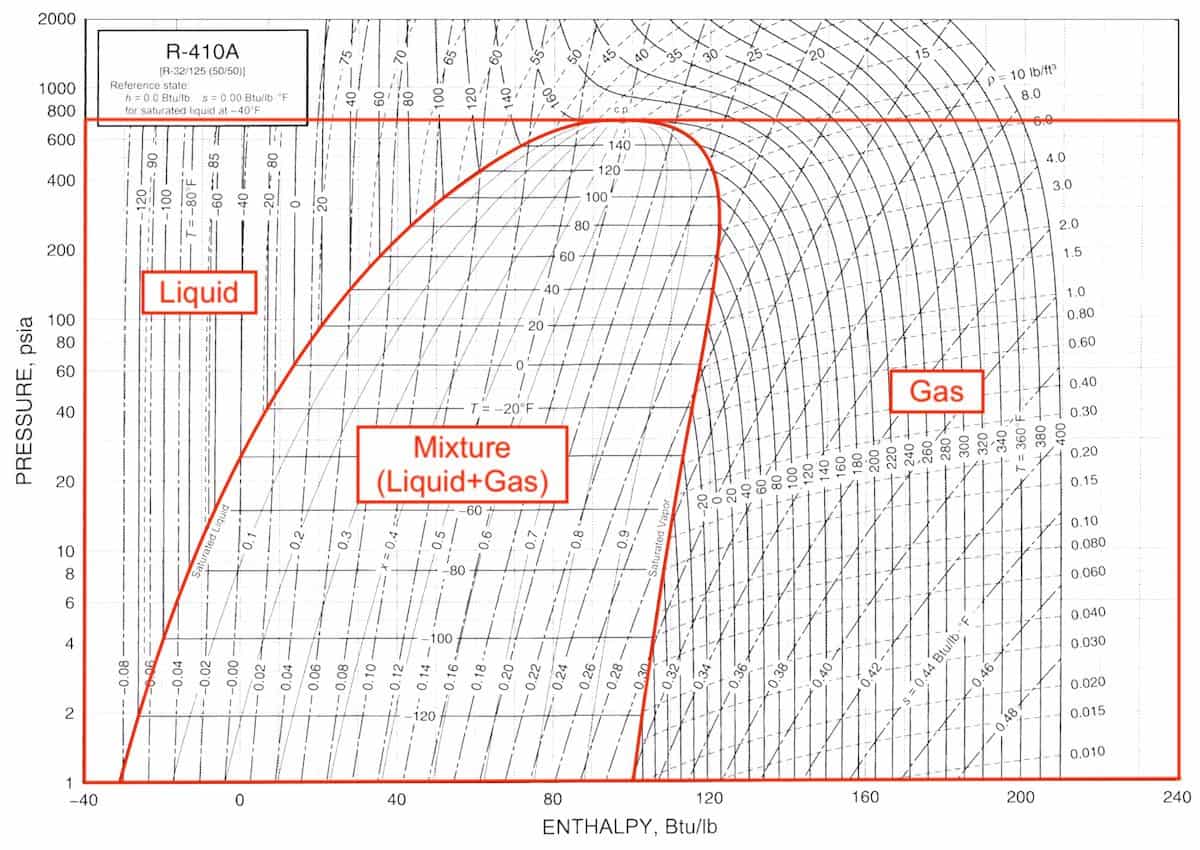
The state of the refrigerant is another common information most people know. On the left side of the PH diagram is where the refrigerant is in liquid form (saturated liquid). On the right side of the PH diagram is where the refrigerant is in the gas form (saturated vapor).
In the middle of the PH diagram (area under the curve) is where the refrigerant in a mixture of liquid and gas form.
In a refrigeration system, we want the refrigerant to turn from liquid to gas and then from gas back to liquid so that we can move energy around effectively.
Refrigerant Temperature
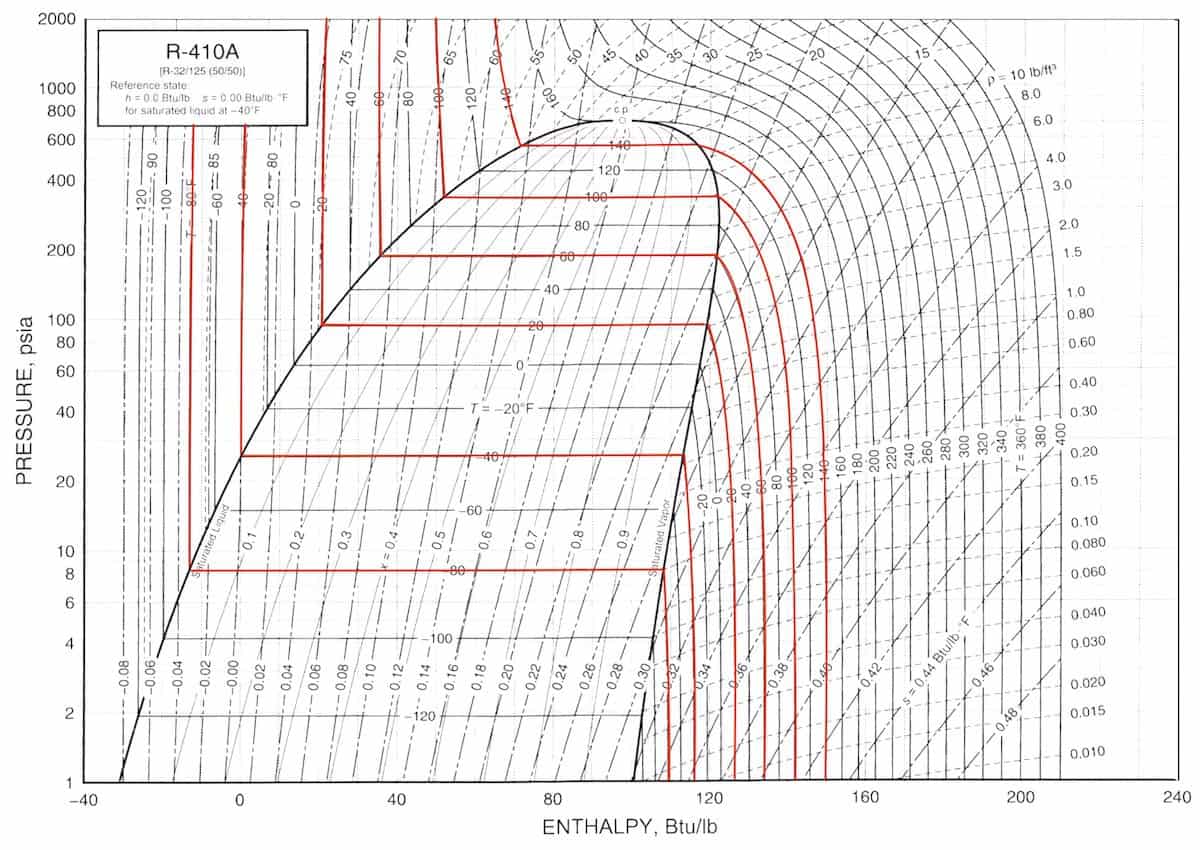
The line coming from the top and bends to the bottom of the PH diagram represents the temperature of the refrigerant in Fahrenheit (Celsius in SI). Notice that the temperature of the refrigerant remains constant across the mixture state. This is because energy is used for phase change instead of rising the temperature of the refrigerant.
The Refrigeration Cycle on PH diagram
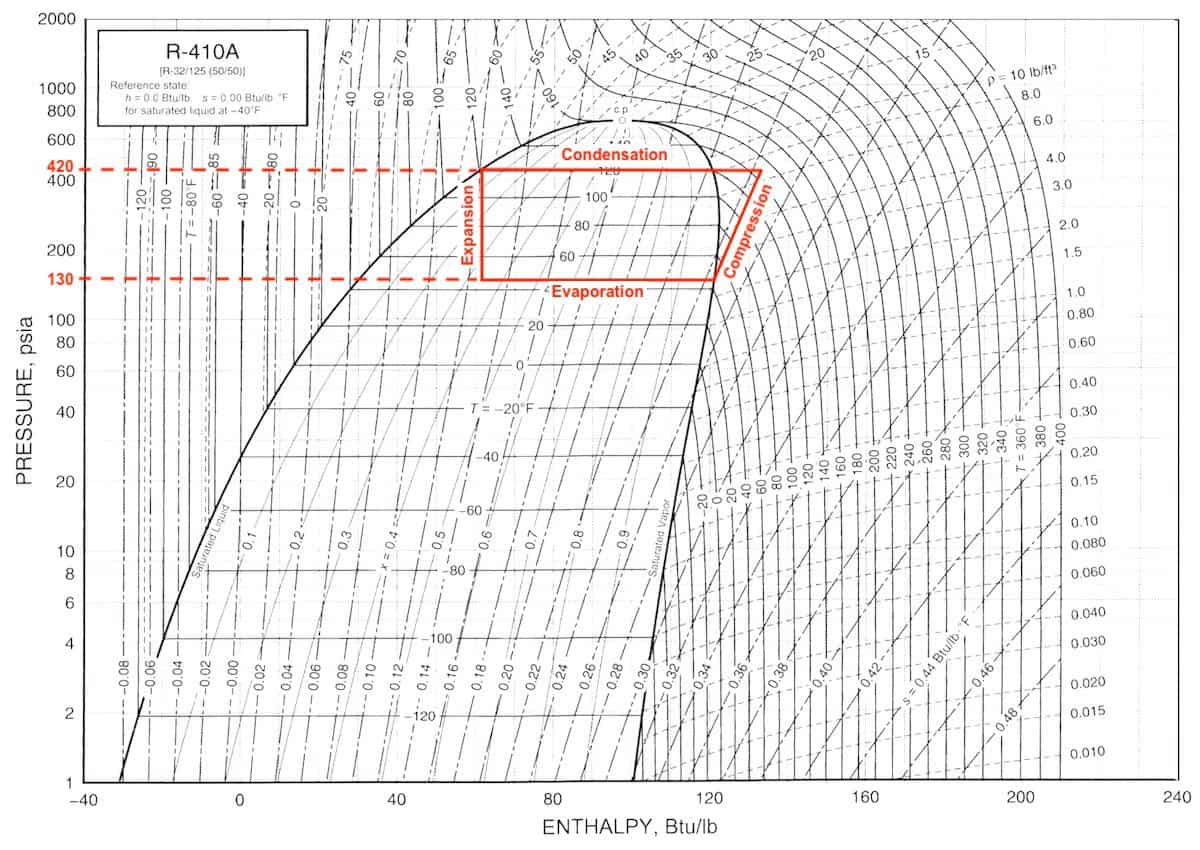
The vapor-compression refrigeration cycle is comprised of 4 processes; a) compression, b) condensation, c) expansion and d) evaporation.
During the condensation process, heat must be rejected so that the refrigerant turns from gas to liquid. Whereas during the evaporation process, heat must be absorbed so that the refrigerant turns from liquid to gas.
The compression process is where power is given to the refrigeration cycle while the expansion process is where we control the amount of refrigerant (via an expansion valve) allowed to evaporate based on our desired outcome.
Heat Absorption (Cooling)
We know that at around 75°F (24°C) is where most people feel comfortable. So, in order to cool the space, heat must be taken away from the space.
Thus, we need to design the system such that the refrigerant is colder than the space so that heat can be transferred from the space to the refrigerant. So, the refrigerant evaporating temperature is normally designed at around 45°F (7°C).
Based on the refrigerant temperature, we can see from the PH diagram that the corresponding refrigerant pressure is around 130 psi and this is the typical suction pressure (suction line) of an R410A air conditioner.
The refrigerant undergoes the evaporation process at a constant pressure as energy is used for phase change.
Heat Rejection (Condensation)
When designing the refrigerant temperature for the condensation process, we need to account for the outdoor air temperature, which varies based on geographical location.
Hence, air conditioners are designed based on the AHRI conditions where the outdoor air temperature is assumed to be at 95°F (35°C).
Thus, the refrigerant temperature needs to be higher than the outdoor air temperature in order to transfer heat from the refrigerant to the outdoor air. So, the refrigerant condensing temperature is normally designed at around 120°F (49°C).
Based on the refrigerant temperature, we can see from the PH diagram that the corresponding refrigeration pressure is around 420 psi and this is the typical discharge pressure (discharge line) of an R410A air conditioner.
Similarly, the refrigerant undergoes the condensation process at a constant pressure as energy is used for phase change.
How to Calculate Refrigeration Effect?
Refrigeration effect (RE) basically is the amount of heat absorbed by the refrigerant. Similarly, it represents the capacity of the refrigerant to absorb heat.
In other words, the cooling capacity of air conditioners is the refrigeration effect.
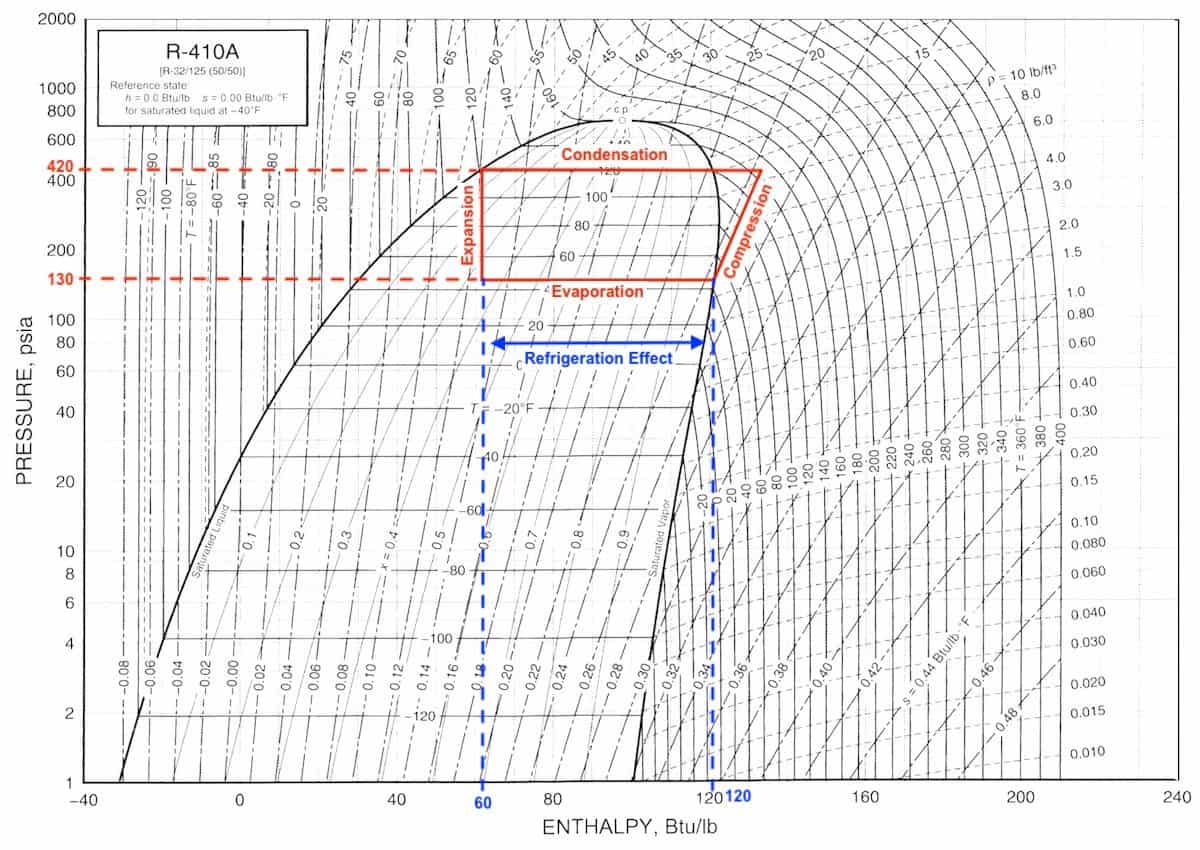
To calculate the refrigeration effect, subtract the enthalpy of the refrigerant after the evaporation process from the enthalpy of the refrigerant before the evaporation process.
For example, from the above diagram, the enthalpy of the refrigerant before and after the evaporation process is 60 btu/lb and 120 btu/lb respectively. Therefore, the refrigeration effect is 60 btu/lb.
Additionally, we can use the following formula to calculate cooling capacity:
Cooling Capacity = Refrigerant Mass Flow Rate x Refrigeration Effect
Let’s say the refrigerant mass flow rate is 2.5 lb/min, the cooling capacity is then:
Cooling Capacity = 2.5 lb/min x 60 btu/lb
Cooling Capacity = 150 btu/min
Now, we convert it into btu/hr for more context:
Cooling Capacity = 150 btu/min x 60 min/hr
Cooling Capacity = 9000 btu/hr (0.75 ton)
We can say that the greater the amount of refrigerant in the system, the higher the cooling capacity of the air conditioner. However, it is not entirely true because the refrigeration effect which is affected by the operating pressure of the refrigerant is also affecting the cooling capacity of the air conditioner.
How to Calculate Compressor Power Input?
Using the PH diagram for refrigeration cycle, we also can calculate the power consumption of the compressor.
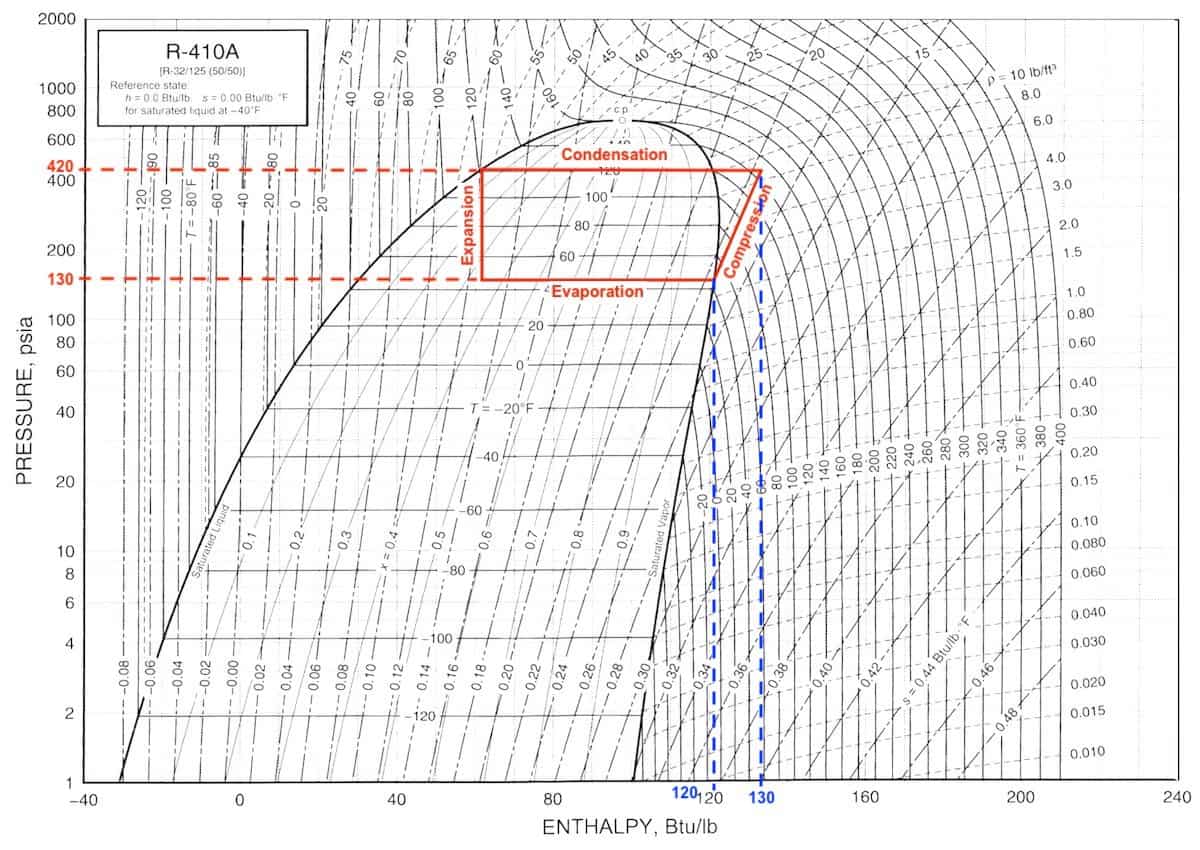
To calculate compressor power input, subtract the enthalpy of the refrigerant after the compression process from the enthalpy of the refrigerant before the compression process.
For example, from the above diagram, the enthalpy of the refrigerant before and after the compression process is 120 btu/lb and 130 btu/lb respectively. Therefore, the enthalpy difference for the compression process is 10 btu/lb.
Since 1 kW equals 3412 btu/hr, 10 btu/lb of compression power equals 0.00293 kW.hr/lb.
Now, assuming the same refrigerant mass flow rate of 2.5 lb/min, the power input can be calculated as follow:
Power Input = Refrigerant Mass Flow Rate x Enthalpy of Compression
Power Input = 2.5 lb/min x 0.00293 kW.hr/lb x 60 min/hr
Power Input = 0.4395 kW = 439.5 W
Generally, a 9000 BTU air conditioner with decent efficiency has a total power input of around 600 W which included the power needed for the fans and various electronics.
How to Calculate Refrigeration Efficiency?
With the refrigeration effect and the compressor power input, the refrigeration efficiency can be calculated by dividing the refrigeration effect by the compressor power input.
Basically, the refrigeration effect is the output of the system and the compressor power input is the input of the system. As we know efficiency is the ratio between output and input, refrigeration efficiency can be calculated.
For example, if the refrigeration effect and the compressor power input are 60 btu/lb and 10 btu/lb respectively, the refrigeration efficiency is 6.
In other words, the coefficient of performance (COP) is 6.
Nowadays, the efficiency of air conditioners is calculated in many ways. A relatable one is the energy efficiency ratio or EER.
EER is calculated by dividing the cooling capacity of the air conditioner (in btu/hr) by the power input of the air conditioner (in W).
For simplicity, let’s use the value we calculated earlier to calculate the EER as follow:
EER = 9000 btu/hr ÷ 439.5 W
EER = 20.48
Obviously, an EER of 20.48 is not the actual efficiency of the air conditioner because the power input for other components is not included. Generally, the EER of a decently designed 9000 BTU air conditioner is around 15.
Basically, refrigeration efficiency is the ratio between the refrigeration effect and the compressor power input. Increasing the refrigeration effect and reducing the compressor power input will increase the refrigeration efficiency.
What are Superheating and Subcooling?
Superheating happens when heat continues being absorbed by the refrigerant even after the refrigerant has fully changed from liquid to gas form.
Similarly, subcooling happens when heat continues being rejected by the refrigerant even after the refrigerant has fully changed from gas to liquid form.
So far, the PH diagram I’ve shown is the ideal case. There is no superheating and subcooling involved.
However, in reality, superheating and subcooling are necessary to ensure the refrigerant is fully evaporated and condensed to maximize efficiency.

We all know that liquid can’t be compressed. Hence, when the refrigerant is entering the compressor, we must ensure that it is fully evaporated into the gas form so that the compressor will not be damaged.
In reality, factors such as control delay and low cooling load can cause the refrigerant to not fully evaporate into gas form. So, the evaporation process is extended such that under normal circumstances, the evaporated refrigerant will undergo superheating before going into the compressor.
The superheating process acts as a safety margin to ensure 100% evaporation.
On the other hand, if the gas refrigerant does not fully condensate into liquid form, the cooling capacity that could otherwise be used is wasted. Thus, to ensure the cooling capacity of the refrigerant is fully utilized, the liquid refrigerant will undergo subcooling.
The subcooling process acts as a safety margin to ensure 100% capacity utilization.
In addition, notice that the gradient of the compression process in the above diagram is not as steep as the one in the ideal PH diagram. This is because, in reality, the enthalpy of the refrigerant not only increases due to the compression process but also due to the absorption of the heat produced by the compressor itself. In the ideal refrigeration cycle, the system goes through the isentropic compression which excluded the internal heat gain from the compressor.
Lastly, consider my HVAC Begin (eBook) if you’re a beginner and you want to have a foundational knowledge in HVAC. But, if you have a year or two of experience, then I would suggest you consider my HVAC Basics (eBook). Nonetheless, I encourage you enroll in my HVAC Beginner Course: 10 Days to Become Competent in HVAC if you want to equipped yourself with a complete set of basic HVAC skills.
HVAC Beginner Course
Learn the most basics and foundational HVAC skills including cooling capacity calculation, equipment selection, duct sizing, pipe sizing, exhaust fan sizing, controls, electrical and more.
If you have anything to add (or ask) about this topic, leave a comment down below!



